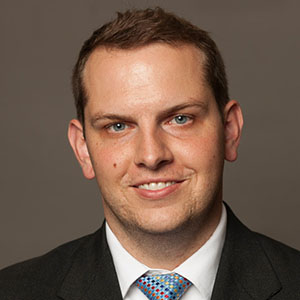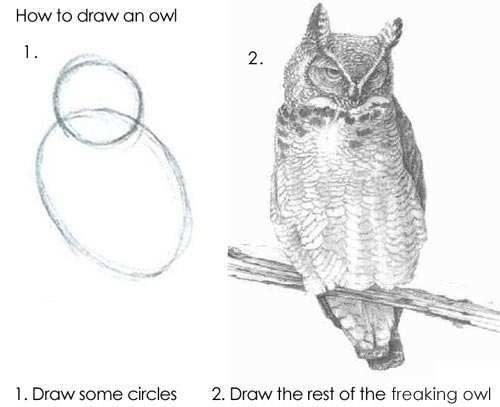How to Draw an Owl

by Ace Stryker, MBA ‘16

Applying in-class MBA frameworks to ambiguous business situations which result in meaningful recommendations can be much like drawing an owl.
The first-year MBA core and immersion experience at Johnson can feel a little like this:

The professors in your classes are tremendously helpful atgetting you through step one. You spend much of your time in class learning andpracticing frameworks that could apply in business situations (the sum of whichcomprises an alphabet soup of acronyms unlikely to feel even vaguely familiar amonth after finals).
Those frameworks can be applied neatly to HBS cases andgenerally yield a set of answers that can be judged in class discussion. Youget a sense after each assignment of whether your approach was right or wrong,based on how the professor approached the same question – that is, whetheryou’ve learned to draw some circles well.
But there comes a time in each first-year MBA student’s life– for many, it’s the integrative case competition at the end of fall semester –when the first unanswered, open-ended, substantial question comes along, andit’s up to you to sift through your toolbox to pick and combine thoseframeworks you think will get you to a useful answer.
Suddenly, the expectation has shifted: It’s no longer enoughto correctly work through the concepts your professors have taught; the realchallenge lies in identifying the key issues and using your judgment todetermine which tools are appropriate, then deciding – without immediate,authoritative feedback – what form the answer should take. This is drawing therest of the freaking owl.
And it can turn out pretty ugly, even if your circles wereperfect.
This is where the Sustainable Global Enterprise (SGE)immersion stands apart – and lessons learned there have been invaluable duringmy summer internship in product management at HP.
In the first couple months of the SGE immersion, I was shockedat how little time we spent reviewing frameworks. Acronyms were few and farbetween. I began to wonder whether I’d made the right choice – friends in themarketing immersion were rapidly accumulating STPs and SAPs and SPSSes andwho-knows-what-else. The finance guys had spreadsheet models that looked to melike hieroglyphics. I was a month into my SGE consulting project with Emersonand still trying to nail down the scope of what we were doing.
Progress on my team’s SGE consulting project was often slow,with frequent stops and even occasional steps backward. The bulk of our effortin the first three months was spent clarifying our client’s key questions andagreeing on what useful final recommendations would look like. It wasn’t untilthe final two months of the project that the pace of actual discovery pickedup, with the team undertaking loads of research around the fairly technicalquestions we were being asked to answer.
A sense of uneasiness lingered for the duration of thesemester. When my team made our final presentation to Emerson, I felt like wehad a good product, but candidly I was unsure what I had learned in five months.Outside of some basic design thinking vocabulary, I couldn’t point to manyconcrete instances in which I thought, “Hey, I just learned to draw a newcircle.”
Then I moved to Palo Alto. Very quickly it dawned on me thatmy employer did not care whether I could draw circles. My ability to calculatediscount rates or convert FIFO to LIFO was meaningless to HP. My mastery ofqueuing theory, formidable though it may be (thanks Prof. Davis!), wasimmaterial. None of the specific tools I’d brought in my box from Johnsonmattered – except to the extent that they helped produce useful insights andrecommendations.
In other words, I learned that in the professional world Iwas going to be judged almost exclusively on my ability to draw the freakingowl.
Almost as soon as I realized that, another thought dawned:That doesn’t scare me. And I have SGE to thank for that.
In retrospect, that’s what my SGE classmates and I had spentthe entire semester previous doing: learning to visualize the owl early on, torefine it over time, and to deliver a good picture at the end. Maybe some of myclassmates got better than me at drawing circles; that’s fine, but it’s only avery small part of what we’re going to be asked to do in our post-MBA careers.
The comfort level that SGE helped me develop with ambiguoussituations, and with structuring a process with my team to forge a new path todeliver meaningful results, can’t be measured on a final exam. But it has madeall the difference this summer.
